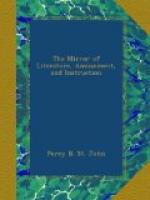Here it may be as well to state that Windsor Castle is divided into the upper and lower wards. The lower contains the ecclesiastical portions of the edifice, including St. George’s Chapel. The upper ward is formed by the celebrated Round Tower on the west; the state apartments, including St. George’s Hall, on the north; and a range of domestic apartments on the east and south, which communicate with the state apartments. The whole building is thus a hollow square, of which the three outer sides on the north, east, and south, are surrounded with a magnificent terrace. The Inner Court, or Quadrangle, is a connected building of three sides, the fourth being formed by the Round Tower, or Keep.
The improvements of the interior of the Quadrangle having been already detailed by us,[1] we pass on to observe, that the low French windows of St. George’s Hall, which faces the side in our Engraving, have been replaced by long pointed arch windows, of elegant proportions. Nothing can exceed the splendour of the look-out from these windows through the arched entrance to the “lengthened vista,” or Long Walk, as shown in the Engraving. The interior of the Hall is nearly completed; “the length, 200 feet, is too great for the width;"[2] the carved ceiling, and the arms of the Knights of the Garter, from the first institution of the order, are exquisitely emblazoned on shields or escutcheons. Beautifully as they are executed, we scarcely like their whole effect, which is undoubtedly marred by the proportions of the hall itself. Perhaps they are too near a blaze of chivalric splendour for these days of cold calculation. The ball-room, adjoining in St. George’s Hall, is nearly completed. The decorations are gold and white, in the florid style of the time of Louis the Fourteenth, superb and showy; four pieces of tapestry are let into the walls, which, observes the Athenaeum, really look like some of Rubens’s stupendous works now in the Grosvenor collection. We have not seen these apartments since last summer, when the decorations were in a forward state. We were surprised at the coarseness of the gilding, when examined closely; we saw, too, that where one of the entrances to the Ball-room had been heightened, the original, door had been pieced, which was a work of economy we did not look for in the repairs of a palace.




